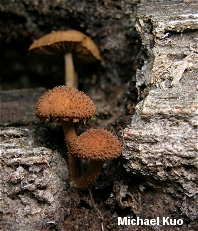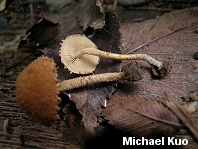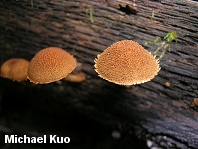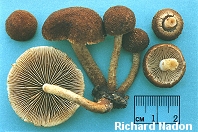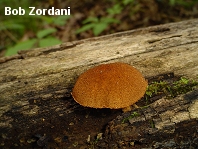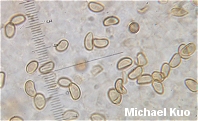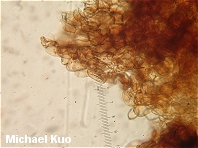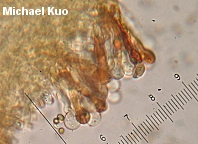| Major Groups > Gilled Mushrooms > Dark-Spored > Wood-Rotting LBMs / Pholiota > Flammulaster erinaceella |

|
Flammulaster erinaceella [ Basidiomycetes > Agaricales > Cortinariaceae > Flammulaster . . . ] by Michael Kuo Flammulaster erinaceella can be separated from similar, granular-capped brown mushrooms by a combination of features:
Compare Flammulaster erinaceella carefully with Pluteus granularis (spore print pink) and Cystoderma granulosum (terrestrial growth, spore print white). Though this species is very distinct, especially when microscopic characters are considered, it is a difficult one to place in established genera; Pholiota and Phaeomarasmius have both housed Flammulaster erinaceella in the past. I know of no DNA studies that have included the mushroom, so molecular evidence cannot yet help to resolve the issue. Pholiota erinaceella and Phaeomarasmius erinaceellus (misspelled by Singer and several subsequent authors as "Phaeomarasmius erinaceella") are synonyms. Description: Ecology: Saprobic on the dead wood of hardwoods; usually found on fallen, well decayed, decorticated logs; spring through fall; probably widely distributed east of the Great Plains, but more common in northeastern North America. I have found it in southern Illinois and in Missouri (in an ecosystem that parallels the baldcypress swamps of the Gulf Coast). Cap: 1-4 cm; convex becoming flat; dry; densely covered with granular scales that often become powdery; dark brown to dark rusty brown; the margin sometimes hung with remnants of the partial veil. Gills: Attached to the stem; close; whitish at first, becoming brownish; often with frayed-looking edges. Stem: 3-4 cm long; under 5 mm thick; equal; covered with granular scales like the cap, but often less densely, revealing the paler color of the stem surface underneath; usually featuring a ring zone. Flesh: Insubstantial. Odor and Taste: Odor not distinctive; taste mild, bitter, or metallic. Spore Print: Pale cinnamon brown. Chemical Reactions: KOH red, then black on cap surface, dark reddish brown on flesh; iron salts olive on flesh. Microscopic Features: Spores 6-9 x 4-5 µ; smooth; more or less elliptical; yellowish to brownish in KOH; yellowish in Melzer's. Basidia narrowly clavate; 4-sterigmate. Pleurocystidia absent. Cheilocystidia abundant; cylindrical below, with a bulbous, capitate end; up to 100 x 16 µ (at least over 50 µ long); hyaline to rusty brown in KOH. Pileipellis with chained, subglobose to irregular elements measuring up to 36 µ across, rusty brown in KOH. REFERENCES: (Peck, 1878) Watling, 1967. (Kauffman, 1918; Overholts, 1927; Smith & Hesler, 1968; Smith, Smith & Weber, 1979; Lincoff, 1992; Roody, 2003.) Herb. Kuo 05300409, 09240505, 09160601, 09120801, 08080902, 05121202. This site contains no information about the edibility or toxicity of mushrooms. |
© MushroomExpert.Com |
|
Cite this page as: Kuo, M. (2007, March). Flammulaster erinaceella. Retrieved from the MushroomExpert.Com Web site: http://www.mushroomexpert.com/flammulaster_erinaceella.html |
